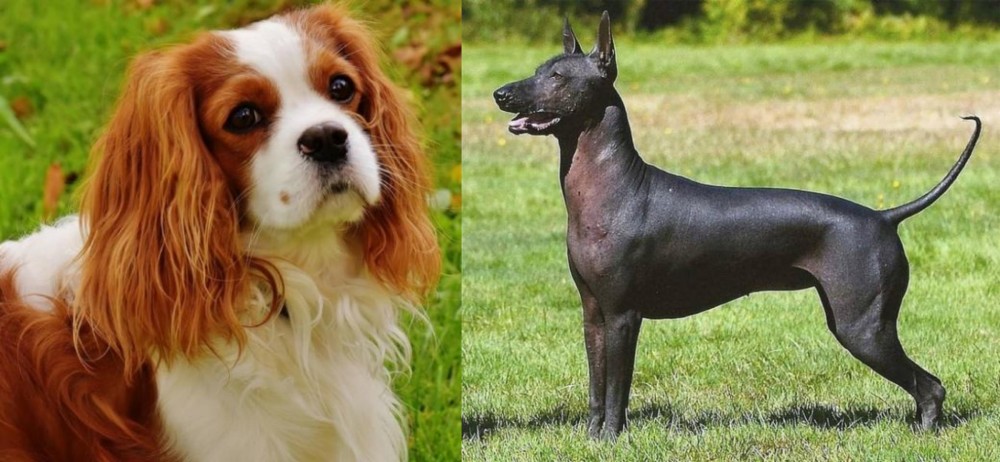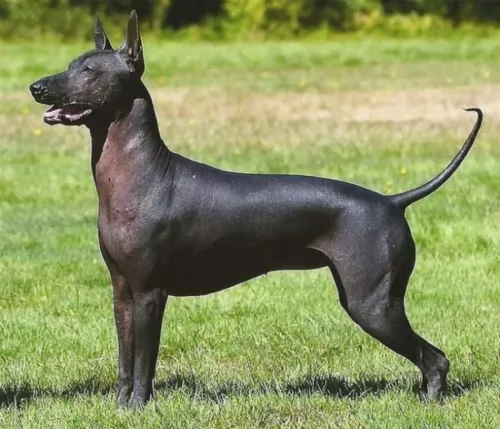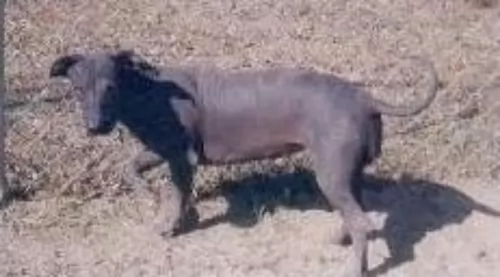 Petzlover
Petzlover Cavalier King Charles Spaniel is originated from United Kingdom but Hairless Khala is originated from Mexico. Cavalier King Charles Spaniel may grow 8 cm / 3 inches shorter than Hairless Khala. Both Cavalier King Charles Spaniel and Hairless Khala are having almost same weight. Both Cavalier King Charles Spaniel and Hairless Khala has same life span. Both Cavalier King Charles Spaniel and Hairless Khala has almost same litter size. Both Cavalier King Charles Spaniel and Hairless Khala requires Moderate Maintenance.
Cavalier King Charles Spaniel is originated from United Kingdom but Hairless Khala is originated from Mexico. Cavalier King Charles Spaniel may grow 8 cm / 3 inches shorter than Hairless Khala. Both Cavalier King Charles Spaniel and Hairless Khala are having almost same weight. Both Cavalier King Charles Spaniel and Hairless Khala has same life span. Both Cavalier King Charles Spaniel and Hairless Khala has almost same litter size. Both Cavalier King Charles Spaniel and Hairless Khala requires Moderate Maintenance.
 The origin of the Cavalier King Charles Spaniel goes back many centuries. It was in 1928 that this spaniel breed was separated from the smaller King Charles and these were particularly popular with royalty in England.
The origin of the Cavalier King Charles Spaniel goes back many centuries. It was in 1928 that this spaniel breed was separated from the smaller King Charles and these were particularly popular with royalty in England.
In fact, Mary, Queen of Scots had one of these spaniels who accompanied her to her beheading. It was her grandsons who gave their name to the breed, and King Charles II, who reigned from 1660 to 1685 kept these dogs. After Charles II's death, the dog’s popularity waned somewhat. The dog was later bred with pugs giving them the familiar features they have today, such as the domed head and the shorter nose.
Interest in the breed revived, and a breed -club was established, drawing up a breed standard. Finally, in 1945, the Cavalier King Charles Spaniel was recognized as a separate breed.
 The Hairless Khala is from a number of Latin American countries, and these countries have a variety of these hairless hounds.
The Hairless Khala is from a number of Latin American countries, and these countries have a variety of these hairless hounds.
The dogs are known by different names. Khala is the Bolivian Quechua Indian name and it means 'no clothing' - an absence of fur. Both Central and South America have their hairless dogs, descendants of ancestral dogs owned by the Incan Empire.
 The Cavalier King Charles Spaniel is a small to medium sized dog wih its height being 31 – 33cm and its weight being 5 – 8 or 9 kg. He is known for his long, silky coat which is fairly straight and feathery.
The Cavalier King Charles Spaniel is a small to medium sized dog wih its height being 31 – 33cm and its weight being 5 – 8 or 9 kg. He is known for his long, silky coat which is fairly straight and feathery.
He has floppy ears, and with this Spaniel breed the tail is generally left long and feathery. The coat comes in many different colors so you will find the popular rich red shade with white, he can be black and tan or even tri-color.
The Cavalier King Charles Spaniel is affectionate, playful and eager to please. He makes an excellent pet for children as well and gets on well with other pets in the home too.
They adapt quickly to different environments and will be happy in the city or in the country, so long as his owner is with him and meters out lots of love and attention. He is intelligent and responds well to training and socialization, turning him from a playful puppy into a relaxed, obedient adult dog.
The Cavalier loves to be active but he also loves to be quietly lying next to his owner. It is also why these dogs make such splendid companions for the elderly as well as being a good choice for therapy dogs.
 There are 2 kinds of hairless Khalas – the Medio one which is a short legged dog which stands at roughly 36 – 41cm in height and weighs roughly 6 – 14kg. The other kind of khala is the Hairless Khala Grande, a long legged type.
There are 2 kinds of hairless Khalas – the Medio one which is a short legged dog which stands at roughly 36 – 41cm in height and weighs roughly 6 – 14kg. The other kind of khala is the Hairless Khala Grande, a long legged type.
Although the dog is hairless, you'll find some hair on the top of his head. For sake of space we'll refer to the Medio variety, a medium-sized hound with hairless skin which is dark grey in color.
The Hairless Khala is a friendly dog with his family but tends to be reserved with strangers. He gets on well with children in the home and because he isn't a particularly energetic dog, elderly people also find that he makes a super pet for them.
He is able to adapt easily to city- as well as country living. You need to be careful with him and not allow him out in the garden in the boiling sun as his skin can burn badly. Then again, without fur, he also tends to get cold easily.
He has dark brown eyes and the ears are fairly large in size and erect. He has a chest which is deep and broad and his tail is set fairly low and is held according to his mood.
He is an intelligent dog, and therefore easily trained. He is a loving, loyal dog who is capable of bonding closely with his human family.
 The Cavlier King Charles Spaniel is an affectionate, playful and eager-to-please dog breed that is good with children and other dogs. They will be happy to join you in any games you have in mind but will easily lie quietly beside you for companionship too.
The Cavlier King Charles Spaniel is an affectionate, playful and eager-to-please dog breed that is good with children and other dogs. They will be happy to join you in any games you have in mind but will easily lie quietly beside you for companionship too.
This spaniel breed is exceptionally intelligent and can be easily trained and socialized, making them even better behaved dogs.
For their gentle, sweet nature, it is no wonder that they make such excellent therapy dogs for children and adults, and he is willing to be a wonderful friend to you too.
 The Hairless Khala will make you an excellent pet, and children and the elderly are attracted to the dog because it is loving and docile. They are aloof with strangers, but training and socialization make him far more tolerant of strangers.
The Hairless Khala will make you an excellent pet, and children and the elderly are attracted to the dog because it is loving and docile. They are aloof with strangers, but training and socialization make him far more tolerant of strangers.
The Hairless Khala is an adaptable dog breed, and will adapt well to life in the city or in the country. Found throughout the Latin American nations, today he is essentially a companion dog, loving to be a devoted friend to his human family.
 Cavaliers are generally fairly healthy dogs but they are prone to mitral valve disease which can lead to heart failure. The heart as 4 chambers and each chamber has a one-way valve to keep blood from flowing backward. One of these is the mitral valve and it can leak over time resulting in a heart murmur. Dogs as young as 4 years of age can develop a murmur from a leaking mitral valve.
Cavaliers are generally fairly healthy dogs but they are prone to mitral valve disease which can lead to heart failure. The heart as 4 chambers and each chamber has a one-way valve to keep blood from flowing backward. One of these is the mitral valve and it can leak over time resulting in a heart murmur. Dogs as young as 4 years of age can develop a murmur from a leaking mitral valve.
Congestive heart failure develops, your dog has a chronic cough and lacks stamina. A veterinary cardiologist may need to be called in to recommend some kind of medical intervention. The vet will evaluate your pet's condition and lifestyle before making a recommendation.
Other health problems which the Cavalier might have to contend with will be luxating patella as well as eye issues.
This condition affects toy breeds, occuring when the kneecaps slip out of place. It can be severe enough to cause lameness in the dogs leg, but fortunately it can be managed with an anti-inflammatory or even surgery.
 The life expectancy of this dog is 10-14 years when he is treated well. The Hairless Khala is a robust dog breed but even so, there are diseases to look out for -
The life expectancy of this dog is 10-14 years when he is treated well. The Hairless Khala is a robust dog breed but even so, there are diseases to look out for -
Skin allergies are one of the reasons you may have to take your Hairless Khala to the vet. These sorts of skin allergies can be frustrating for a dog because the skin is irritated and itchy and he may have scaly areas or red bumps on his skin. If your dog is licking and scratching frantically, you will need to get him to the vet.
Periodontal disease is inflammation of the gums, and if food and bacteria accumulate on the gums, it forms plaque and transforms into calculus, leading to gingivitis. Check your pet's teeth regularly and also brush them with special canine toothbrush and toothpaste at least 2 or 3x a week.
 The Cavalier Spaniel’s long silky coat will require brushing at least twice a week to remove loose hairs and to keep it healthy and shiny. This is one spaniel however, that won’t require trimming. However, because he loves to be playing outdoors, some owners do trim the dog’s feathers around the legs and paws.
The Cavalier Spaniel’s long silky coat will require brushing at least twice a week to remove loose hairs and to keep it healthy and shiny. This is one spaniel however, that won’t require trimming. However, because he loves to be playing outdoors, some owners do trim the dog’s feathers around the legs and paws.
As a dog with floppy ears, it will become essential to check his ears for wax build-up and moisture within the ears combined with dirt. This can lead to ear infections. Also the silky ears can be prone to matting. You can wash them gently with dog shampoo.
Smaller dogs like the Cavalier Spaniel are more likely to develop dental problems because of the structure of their skulls and jaws which are more compressed. Brush your dogs teeth 2 or 3 times a week with special canine tooth-paste and toothbrush.
 He isn't a super energetic dog but still, he will need to be taken for a walk every day.You can also include typical games that all dogs love – fetching a ball or pulling on a rope.
He isn't a super energetic dog but still, he will need to be taken for a walk every day.You can also include typical games that all dogs love – fetching a ball or pulling on a rope.
Because of the dog having little or no hair, they are considered fairly hypoallergenic and also low maintenance. You'd need to brush a dog with fur, but a hairless dog requires different grooming.
Speak to your vet about bathing your dog, the type of body wash to use and how frequently it should be done. Because your dog is hairless, he may require a sun cream in the Summer and a jersey in the Winter.
He will also need his nails clipped and his teeth brushed as part of his grooming process.
He may not have much hair, but when it comes to diet he is much the same as any other dog. If you feed him commercially manufactured food, always choose the best quality one in accordance with his age, height and activity levels.
Home-made food is always a welcome treat for your pet, but whatever you feed him, make sure it has the necessary minerals and vitamins to ensure his health. Essential fatty acids will be needed to keep the skin moist. With too much washing, the skin of these dogs will become irritated, dry and flaking if he doesn't received a nutritious, balanced diet. Make sure he has constant access to fresh, cool water.
When in any doubt as to how to look after a hairless dog, speak to your vet.